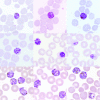Plasmodium malariae: parasite and disease
- PMID: 17934075
- PMCID: PMC2176047
- DOI: 10.1128/CMR.00027-07
Plasmodium malariae: parasite and disease
Abstract
A review of the life history of Plasmodium malariae, the quartan malaria parasite of humans, is presented. Much of the information is based on data obtained from induced infections in humans who were given malaria therapy for the treatment of neurosyphilis between 1940 and 1963. Prepatent periods (i.e., the time until the first day of parasite detection) fever episodes, and maximum parasitemias as a result of infection with P. malariae were obtained and are presented. Experimental and known vectors of the parasite are also discussed. Splenectomized chimpanzees and New World monkeys are readily infected and serve as sources of parasites and antigens for diagnostic and molecular studies. South American monkeys are naturally infected with a parasite known as Plasmodium brasilianum. This parasite appears to be P. malariae that has adapted from humans to grow in monkeys, probably within the last 500 years. Infection with P. malariae is associated with the production of immune complexes in the kidneys and the associated nephrotic syndrome. The essential lesions are a thickening of the glomerular basement membrane and endocapillary cell proliferation. Studies of monkeys infected with P. malariae indicate the same pathology as that demonstrated in humans.
Figures







References
-
- Aikawa, M., J. R. Broderson, I. Igarashi, G. Jacobs, M. Pappaioanou, W. E. Collins, and C. C. Campbell. 1988. An atlas of renal disease in Aotus monkeys with experimental plasmodial infection, p. 1-97. American Institute of Biological Sciences, Washington, DC.
-
- Allison, A. C., V. Houba, R. G. Hendrickse, S. De Petrise, G. M. Edington, and A. Adeniyi. 1969. Immune complexes in the nephritic syndrome of African children. Lancet 1:1232-1238. - PubMed
-
- Anazawa, K. 1931. Experimental studies on the infectibility of anopheline mosquitoes of Formosa. J. Med. Assoc. Formosa 30:609-632.
-
- Atkinson, C. T., M. Aikawa, A. P. Rock, K. Marsh, P. M. Andrysiak, G. H. Campbell, W. E. Collins, and R. J. Howard. 1987. Ultrastructure of the erythrocytic stages of Plasmodium malariae. J. Protozool. 34:267-274. - PubMed
-
- Averbouch, I. 1930. Expériences sur la transmission á l'homme de la fiévre quarte par les piqûres d'Anopheles maculipennis var saccharovi. Rev. Microbiol. Epid. Parasit. 9:379-381.
Publication types
MeSH terms
LinkOut - more resources
Full Text Sources
Medical

